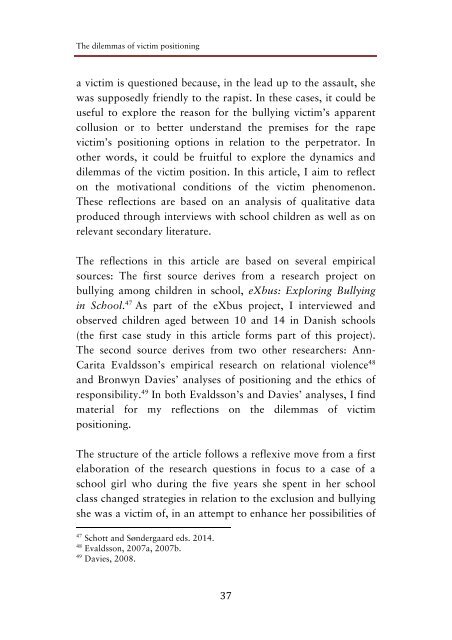You also want an ePaper? Increase the reach of your titles
YUMPU automatically turns print PDFs into web optimized ePapers that Google loves.
The dilemmas of victim positioning<br />
a victim is questioned because, in the lead up to the assault, she<br />
was supposedly friendly to the rapist. In these cases, it could be<br />
useful to explore the reason for the bullying victim’s apparent<br />
collusion or to better understand the premises for the rape<br />
victim’s positioning options in relation to the perpetrator. In<br />
other words, it could be fruitful to explore the dynamics and<br />
dilemmas of the victim position. In this article, I aim to reflect<br />
on the motivational conditions of the victim phenomenon.<br />
These reflections are based on an analysis of qualitative data<br />
produced through <strong>inte</strong>rviews with school children as well as on<br />
relevant secondary literature.<br />
The reflections in this article are based on several empirical<br />
sources: The first source derives from a research project on<br />
bullying among children in school, eXbus: Exploring Bullying<br />
in School. 47 As part of the eXbus project, I <strong>inte</strong>rviewed and<br />
observed children aged between 10 and 14 in Danish schools<br />
(the first case study in this article forms part of this project).<br />
The second source derives from two other researchers: Ann-<br />
Carita Evaldsson’s empirical research on relational violence 48<br />
and Bronwyn Davies’ analyses of positioning and the ethics of<br />
responsibility. 49 In both Evaldsson’s and Davies’ analyses, I find<br />
material for my reflections on the dilemmas of victim<br />
positioning.<br />
The structure of the article follows a reflexive move from a first<br />
elaboration of the research questions in focus to a case of a<br />
school girl who during the five years she spent in her school<br />
class changed strategies in relation to the exclusion and bullying<br />
she was a victim of, in an attempt to enhance her possibilities of<br />
47<br />
Schott and Søndergaard eds. 2014.<br />
48<br />
Evaldsson, 2007a, 2007b.<br />
49<br />
Davies, 2008. <br />
37


